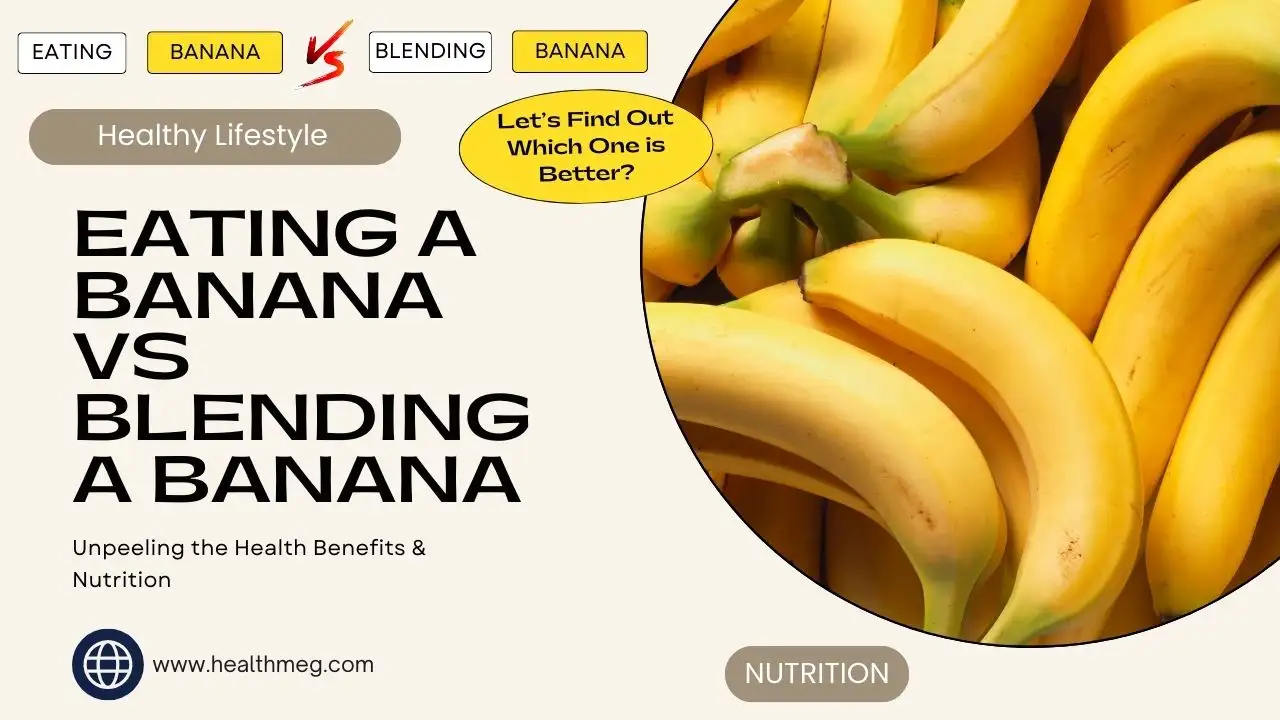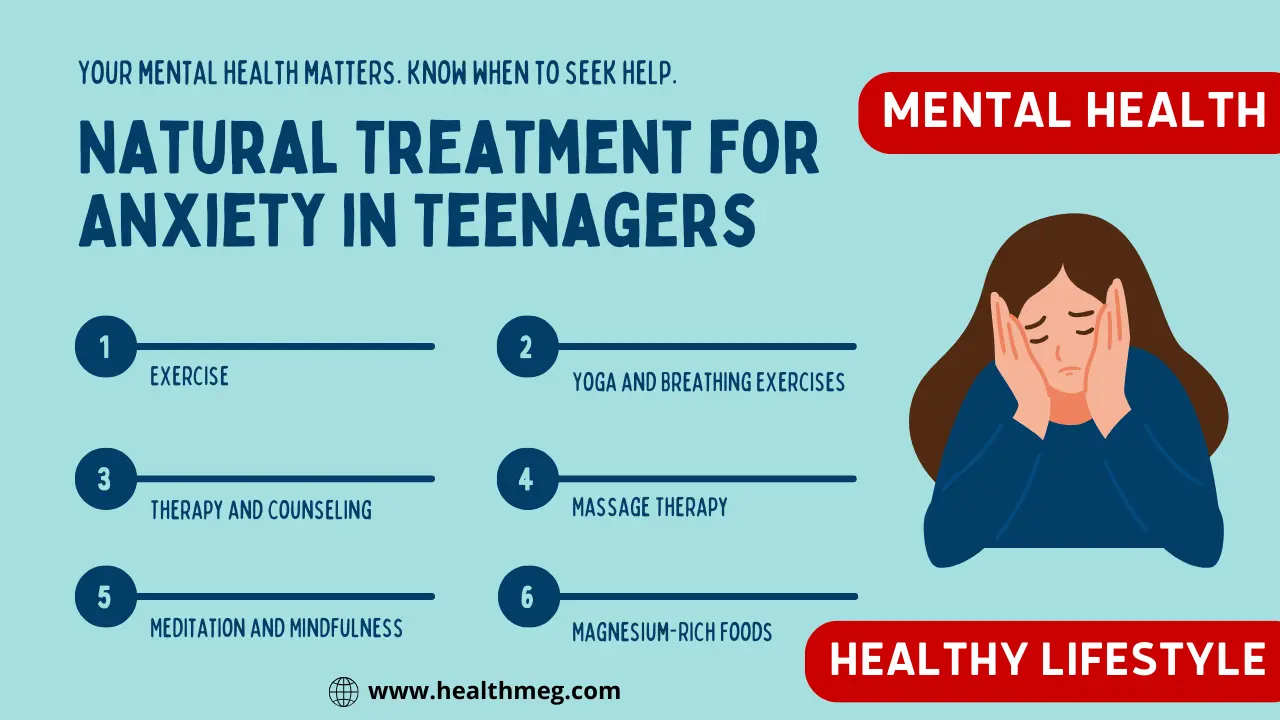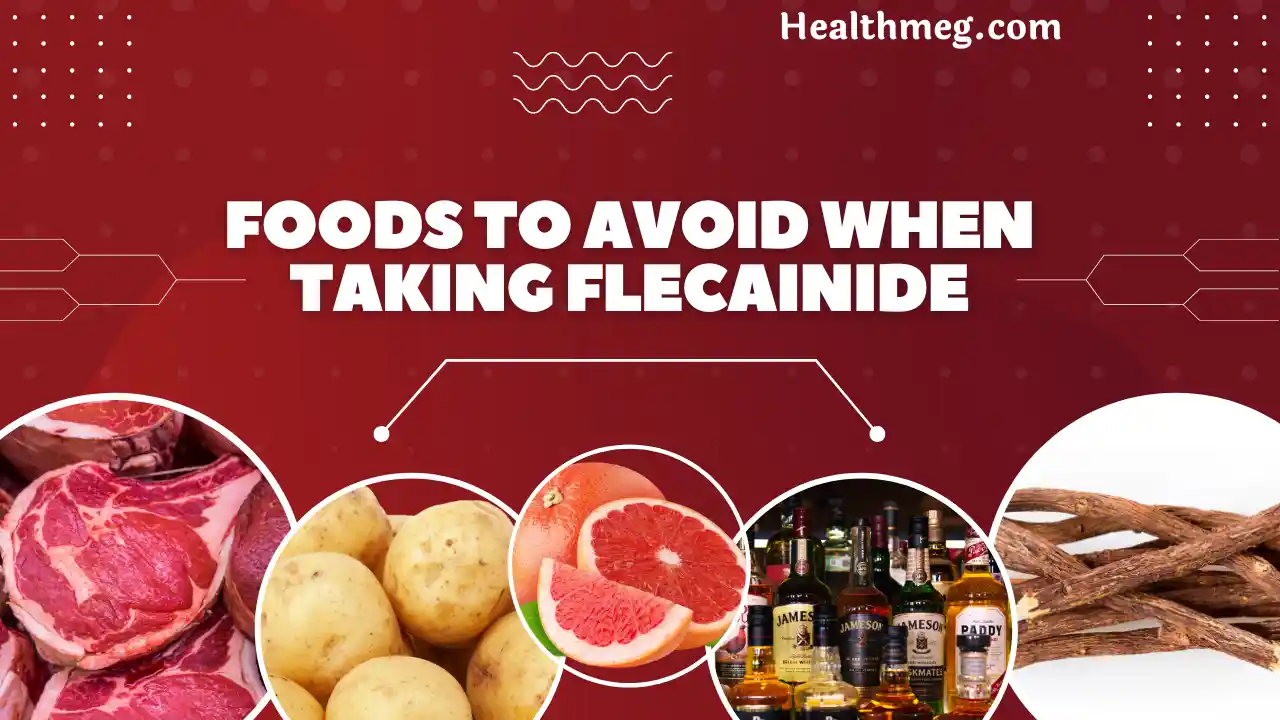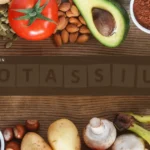Introduction
Bananas are one of the world’s most popular fruits, packed with essential vitamins and minerals. They offer an easy and portable snack, but does the method of consumption – “Eating a Banana vs Blending a Banana” – impact its nutritional value and health benefits? This article will analyze the latest scientific research to uncover key differences in fibre content, nutrient bioavailability, glycemic response, antioxidant levels, and more when you compare eating a banana to blending a banana. Read on for an evidence-based comparison to help you determine the best way to enjoy bananas for your health goals.
Do read the People Also Ask (FAQs) about this topic.
Key Takeaway
| Key Takeaways |
|---|
| Eating whole bananas provides more satiating fibre, intact antioxidants, and slower-digesting carbs for longer-lasting energy. This makes leaving bananas whole better for weight management, gut health, and stabilizing blood sugar. |
| Blending bananas into smoothies allows more micronutrients to be absorbed but decreases digestion-slowing fibre. This causes blood sugar spikes, making smoothies less ideal for diabetes, but good pre/post workout when rapid fueling is needed. |
| Chewing whole bananas activates amylase inhibitors that may help balance blood sugar compared to blending. |
| Blended bananas contain fewer surviving prebiotic fibres to feed beneficial gut microbes versus eating whole pieces. |
| The health impacts and ideal consumption method depend on individual factors like nutrition needs, health goals, activity levels, and preferences. |
The Direct Answer: Eating a Banana vs Blending a Banana?
Based on the research, there is no definitive “better” option between eating a whole raw banana and blending it into a smoothie in terms of nutritional value. Each method has unique benefits and downsides.
Eating a whole banana provides more satiating fibre, antioxidants undamaged by blending, and slower-digesting carbohydrates that offer longer-lasting energy. This makes leaving bananas whole ideal for weight management, gut health, and stabilizing blood sugar levels.
However, blending bananas into smoothies liberates more micronutrients like vitamins and minerals for absorption compared to chewing whole pieces. The blending also pre-digests the banana allowing for quicker nutrient uptake to fuel the body rapidly. This makes smoothies advantageous pre or post-workout. But it can also spike blood sugar sharply in those with diabetes.
Ultimately, regularly consuming bananas in both whole and blended smoothie forms can fit into a balanced diet. The optimum approach depends on individual nutritional needs and health priorities. So choose based on your goals, activity levels, and preference for texture.
The Nutritional Profile of a Banana
Bananas offer a variety of essential vitamins, minerals, and plant compounds:
- Dietary fibre – 12% Daily Value per medium banana
- Vitamin C – 12% DV
- Vitamin B6 – 24% DV
- Potassium – 12% DV
- Magnesium – 8% DV
- Manganese – 14% DV
- Dopamine and catechins (antioxidants)
These nutrients contribute to various health benefits, from regulating heart function to building bones and cartilage to producing red blood cells and neurotransmitters for nerve signalling. The nutritional profile of bananas also changes during ripening. As they ripen, starch converts to sugars, causing the glycemic index to rise. Antioxidant levels also fluctuate.
Eating a Banana: Pros and Cons
Eating a fresh banana has its pros and cons:
Pros:
- Provides filling fibre that stabilizes digestion
- Natural sugars digest slowly, preventing blood sugar spikes
- Chewing skin activates amylase inhibitors that may balance blood glucose levels
- Intact prebiotics feed good gut flora, improving microbiome diversity
- Minerals like magnesium and B6 readily absorb when slowly digested
- Portable, budget-friendly, easy to eat out of hand
Cons:
- If unripe, starch and tannins can provoke digestive upset
- Contains moderately high natural sugar content
- Can cause allergic reactions in those with latex sensitivities
- Some find texture or flavour unpleasant
Blending a Banana: Pros and Cons
Blending bananas versus eating them whole also has its pros and cons:
Pros:
- Banana purees or smoothies appeal to more palates, especially kids
- Blending into liquids allows for unique serving methods
- Altering the food matrix can increase the absorption of some antioxidants
- Easy to combine with other fruits and smoothie boosters
Cons:
- Fibrous cell walls degrade, decreasing digestion-slowing fibre
- Spikes blood sugar more aggressively without fibre buffers
- Gut bacteria receive less intact prebiotics to nourish the microbiome
- Some vitamin levels decrease upon exposure to air and blending
Health Benefits: A Comparative Analysis
Considering the differences in digestion, the specific health benefits of bananas vary when eaten whole versus blended. Here’s a comparative analysis:
| Health Aspect | Eating Whole Bananas | Blending Bananas |
|---|---|---|
| Heart Health | Fibers lower cholesterol; potassium regulates blood pressure. | Raises blood sugar, which could harm the heart over time. |
| Blood Sugar Regulation | Moderate GI absorbs slowly, preventing a sugar crash. | Destroys cell walls, causing a rapid spike in blood sugar. |
| Gut/Digestive Health | Fibres induce satiety; steady energy prevents cravings. | Fewer prebiotics survive to nourish good bacteria. |
| Weight Management | Fibres induce satiety; steady energy prevents cravings. | Blended sugars digest fast, leading to hunger cues. |
| Immunity | Some proteins may have antimicrobial effects. | Vitamin C and manganese maintain function either way. |
The Science Behind Digestion: Eating vs Blending
To understand why whole vs. blended bananas offer different effects, let’s compare what happens during digestion.
When chewing bananas, enzymes in your saliva begin breaking down carbohydrate and protein bonds. Once swallowed, additional enzymes further separate nutrients from fibrous cell walls. Intact portions then travel to the colon providing prebiotic nourishment to feed microbiome flora. This results in a slower, more stable metabolic digestion process.
In contrast, a blender rapidly shreds apart cell walls to release banana sugars and starches. Without intact structures, carbs digest quicker, causing a more pronounced spike in blood glucose. Meanwhile, less fibre survives through the gut, reducing food for good bacteria.
So while both allow nutrients to eventually reach your cells, eating whole bananas enables a gentler, more balanced metabolic process compared to blending them.
Fiber Content in Whole vs Blended Bananas
Eating a whole banana rather than a blended one has a significant nutritional advantage due to its fibre content. A medium banana contains 3 grams of fibre, according to Harvard Medical School. Fiber plays crucial roles such as:
- Slowing digestion to stabilize blood sugar
- Supporting a healthy gut microbiome
- Reducing cholesterol
- Promoting regularity
When you blend a banana, the cell walls are broken down, making the fibre easier to digest. As a result, your body doesn’t get the full impact of the insoluble fibre. A study in the European Journal of Clinical Nutrition found that 50% less fibre was extracted from blended apples versus whole chewed ones. Researchers expect similar trends for other fruits like bananas.
This means while blended bananas contain the same total fibre content on paper, you’ll absorb less insoluble fibre that supports bowel health and stable blood sugar.
Glycemic Index Differences
The glycemic index measures how much a food spikes blood sugar. Whole bananas have a moderate GI of 51. Once blended, the GI jumps to 75. The reason blending increases the impact on blood sugar is that the destroyed plant cell walls make the carbs much more accessible to digestive enzymes. The body absorbs the sugars extremely quickly into the bloodstream.
A lower GI is generally considered healthier, as it promotes:
- Better appetite control
- Increased endurance
- Reduced cardiovascular disease risk
- Improved blood glucose regulation
Eating a whole, low-GI banana provides lasting energy thanks to the natural fruit sugars. Blending can cause an unhealthier blood sugar spike and crash effect. This is an important consideration for those managing diabetes or weight.
Nutrient Bioavailability in Blended vs Whole Bananas
Turning fruits like bananas into smoothies makes more of their nutrients available for absorption compared to eating the whole fruit. But does this make blended fruits healthier?
Bioavailability is the proportion of nutrients in foods that your body can digest and use, rather than passing through your digestive tract undigested. Studies show that processing produce – including mashing, pureeing in blenders, and juicing – breaks down plant cell walls, freeing more nutrients from the food matrix that would otherwise be trapped inside intact cells.
For example, one study found that blending mangos increased the absorption of the antioxidants beta-carotene and lutein by over 25% compared to eating sliced mangos. A similar increase in nutrient absorption occurs when spinach cell walls are broken down through blending instead of eating whole leaves.
While there’s no direct research comparing the bioavailability of nutrients from blended bananas versus whole bananas, data from other fruits and vegetables suggest that blending likely makes more of the banana’s vitamins, minerals, and antioxidant contents available for absorption. Potassium, vitamin B6, vitamin C, and carotenoids dissolve into the extracted banana juice, increasing assimilation rather than passing intact through your intestines like fibre-encased nutrients in solid bites of whole banana.
Practical Tips for Incorporating Bananas into Your Diet
Based on similarities and differences in nutrition science, what are practical tips for getting the most benefits from bananas?
- Eat fresh whole bananas as the first choice
- Limit blended bananas to occasional smoothies or treats
- Pair blended bananas with protein, and fat for slower energy
- Add banana peels to compost as prebiotic fertilizer
Getting comfortable with dicing bananas into oatmeal, chilling banana pops, and whipping up banana protein soft serve increases creative ways to eat the whole fruit too.
Conclusion
Both eating whole raw bananas and blending them into smoothies can fit into a healthy, balanced diet. The optimum approach depends on individual nutritional requirements, health priorities, lifestyle factors, and personal tastes.
Eating fresh bananas provides more blood sugar-stabilizing fibre, gut-healthy prebiotics, and longer-fueling carbohydrates. This makes leaving them whole potentially better for weight management, digestion, immunity, and preventing energy crashes.
However, blending bananas into drinks allows more antioxidants and micronutrients to be absorbed rapidly. This can benefit high-intensity exercise performance and recovery. But it also spikes blood sugar more aggressively, which could be detrimental to diabetes.
In the end, regularly consuming bananas in both whole and smoothie forms can offer benefits. Mix up your intake based on your specific goals, activity levels, and textural preferences for versatility.
People Also Ask (FAQs)
Q) Is blending a banana the same as eating it?
A) No, blending a banana is not the same as eating it whole. Blending breaks down cell walls, decreasing fibre and spiking blood sugar more rapidly. This changes the glycemic response compared to chewing the intact fruit.
Q) Is blending a banana less calories?
A) No, blending a banana does not reduce its calorie content. A medium banana contains about 100 calories whether eaten whole or blended. The total calories remain the same.
Q) Is a whole banana healthier than a blended one?
A) In some ways, yes. Whole bananas provide more filling fibre, steady energy release, gut-healthy prebiotics, and unoxidized antioxidants. But blending makes more nutrients bioavailable. So both methods have tradeoffs.
Q) Is a banana more calories when you blend it?
A) No, blending a banana does not increase its calories or nutrient content. The calorie count stays fixed at around 100 calories for a medium-peeled banana.
Q) Does blending a banana make it more calories?
A) No. Blending does not add or multiply calories or nutrients. A medium-sized banana contains 100 calories whether you blend it or eat it whole. The calorie total remains unchanged.
Q) Does blending banana have more calories than eating?
A) No. A banana smoothie does not contain more calories than eating the banana whole. Blending simply breaks down fibre and cell walls but cannot generate more calories.
Q) Does blending fruit reduce calories?
A) No. Blending fruit does not lower or decrease its calorie content. For example, a blended banana still provides 100 calories – the same as eating it whole. Blending just makes absorption faster.
Q) Why is mashed banana more calories?
A) Mashed banana does not contain more calories than whole banana. This myth likely arises from the spike in blood sugar and energy that occurs when cell walls break, releasing sugars. But the calorie count remains fixed.
Q) Does blending bananas increase sugar?
A) No, blending a banana does not generate more sugars or calories. But it does make the fruit’s inherent sugars digest faster by breaking down fibre and cell walls, spiking blood sugar levels more aggressively.
Q) Is a blended banana less healthy?
A) Not necessarily, but it loses some benefits of whole fruit like satiating fibre, gut prebiotics, etc. However, more antioxidants may be absorbed from a smoothie. So both blended and whole bananas have tradeoffs.
Q) Does blending fruit affect weight?
A) Potentially. Whole fruit with skin/seeds could aid weight loss more due to fibre and amylase inhibitors that stabilize digestion. However, no studies directly compare blended fruit smoothies versus eating whole fruit for weight management.












